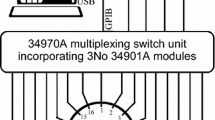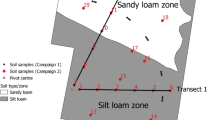Abstract
Electrical capacitance volume tomography (ECVT) is a recently-developed technique for real-time, non-invasive 3D monitoring of processes involving materials with strong contrasts in dielectric permittivity. This work is first application of the method to visualization of water flow in soil. We describe the principles behind the method, and then demonstrate its use with a simple laboratory infiltration experiment. 32 ECVT sensors were installed on the sides of an empty PVC column. Water was poured into the column at a constant rate, and ECVT data were collected every second. The column was then packed with dry sand and again supplied with water at a constant rate with data collected every second. Data were analyzed to give bulk average water contents, which proved consistent with the water supply rates. Data were also analyzed to give 3D images (216 voxels) allowing visualization of the water distribution during the experiments. Result of this work shows that water infiltration into the soil, wall flow, progress of the unstable wetting front and the final water distribution are clearly visible.
Similar content being viewed by others
References
WILKINSON P L, ANDERSON M G, LLOYD D M. An integrated hydrological model for rain-induced landslide prediction [J]. Earth Surface Processes and Landforms, 2002, 27: 1285–1297.
MUKHLISIN M, KOSUGI K, SATOFUKA Y, MIZUYAMA T. Effects of soil porosity on slope stability and debris flow runout at a weathered granitic hillslope [J]. Vadoze Zone Journal, 2006, 5: 283–295
MUKHLISIN M, TAHA M R, KOSUGI K. Numerical analysis of effective soil porosity and soil thickness effects on slope stability at a hillslope of weathered granitic soil formation [J]. Geosciences Journal, 2008, 12 (4): 401–410.
MUKHLISIN M, TAHA M R. Slope stability analysis of a weathered granitic hillslope as effects of soil thickness [J]. European Journal of Scientific Research, 2009, 30(1): 36–44.
MUKHLISIN M, BAIDILLAH M R, TAHA M R, ELSHAFIE A. Effect of soil water retention model on slope stability analysis [J]. International Journal of the Physical Sciences, 2011, 6(19): 4629–4635.
MUKHLISIN M, IDRIS I, YAACOB W Z W, ELSHAFIE A, TAHA M R. Soil slope deformation behavior in relation of soil water interaction based on centrifuge physical modeling [J]. International Journal of the Physical Sciences. 2011, 6(13): 3126–3133.
MUKHLISIN M, TAHA M R. Numerical model of antecedent rainfall effect on slope stability at a hillslope of weathered granitic soil formation [J]. Journal Geological Society of India, 2012, 79: 525–531
HUISMAN J, SPERL C, BOUTEN W, VERSTRATEN J. Soil water content measurements at different scales: Accuracy of time domain reflectometry and ground-penetrating radar. 2001, 48–58.
JACKSON T J, SCHMUGGE T J, RAWLS W J. Soil water infiltration observation with microwave radiometers [J]. IEEE Transaction on Geoscience and Remote Sensing, 1998, 36(5): 1376–1383.
BRUNET P, CLEMENT, R, BOUVIER C. Monitoring soil water content and deficit using electrical resistivity tomography (ERT)-A case study in the Cevennes area, France [J]. Journal of Hydrology, 2010, 380(1/2): 146–153.
BATLLE-AGUILAR J, PESSEL M, TUCHOLKA P, COQUET Y, VACHIER P. Axisymetrical infiltration in soil imaged by noninvasive electrical resistivimetry [J]. Soil Sci Soc Am J, 2009, 73: 510–520.
KOESTEL J, KASTEEL R, KEMNA A, ESSER O, JAVAUX M, BINLEY A, VEREECKEN H. Imaging brilliant blue stained soil by means of electrical resistivity tomography [J]. Vadose Zone J, 2009, 8: 963–975.
DU B, MARASHDEH Q, WARSITO W. Development of electrical capacitance volume tomography (ECVT) and electrostatic tomography (EST) for 3d density imaging of fluidized bed system [C]// The 12th International Conference on Fluiditation, Agassiz, British Columbia, Canada, 2007: 473–480.
WARSITO W, MARASHDEH Q, FAN L S. Electrical capacitance volume tomography [J]. IEEE, Sensors Journals, 2007, 7 (4): 525–535.
HARTEVELD W K, van HALDEREN P A, MUDDE R F, van den BLEEK C M, van den AKKER H E A, SCARLETT B. A fast active differentiator capacitance transducer for electrical capacitance tomography [C]// 1st Word Congress on Industrial Process Tomography. Buxton, Greater, Manchester, 1999: 564–567.
LIONHEART W R B. Reconstruction algorithms for permittivity and conductivity imaging [C]// Proc. 2nd World Congr Industrial Process Tomography. Hannover, Germany, 2001: 4–11.
WU S Y, ZHOU Q Y, WANG G, YANG L, LING C P. The relationship between electrical capacitance-based dielectric constant and soil water content [J]. Environ Earth Sci. 2011, 62: 999–1011.
Author information
Authors and Affiliations
Corresponding author
Rights and permissions
About this article
Cite this article
Mukhlisin, M., Baidillah, M.R. & Taha, M.R. Electrical capacitance volume tomography for measurement soil water infiltration in vessel experiments. J. Cent. South Univ. 21, 358–364 (2014). https://doi.org/10.1007/s11771-014-1948-x
Received:
Accepted:
Published:
Issue Date:
DOI: https://doi.org/10.1007/s11771-014-1948-x




